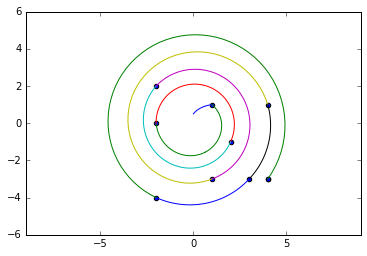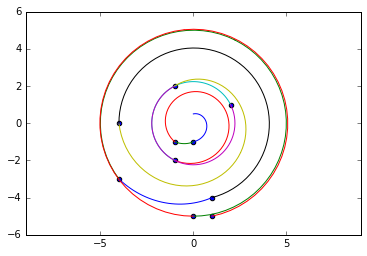With a bit of trigonometry it's not that hard. Maybe you know but the angle between two (normalized) vectors is acos(vec1 * vec2). However this calculates only the projected angle but one could use atan2 to calculate the direction-aware angle.
To this means a function calculating it and then using it as key for sorting would be a good way:
import math
pts = [[2,3], [5,2],[4,1],[3.5,1],[1,2],[2,1],[3,1],[3,3],[4,3]]
origin = [2, 3]
refvec = [0, 1]
def clockwiseangle_and_distance(point):
# Vector between point and the origin: v = p - o
vector = [point[0]-origin[0], point[1]-origin[1]]
# Length of vector: ||v||
lenvector = math.hypot(vector[0], vector[1])
# If length is zero there is no angle
if lenvector == 0:
return -math.pi, 0
# Normalize vector: v/||v||
normalized = [vector[0]/lenvector, vector[1]/lenvector]
dotprod = normalized[0]*refvec[0] + normalized[1]*refvec[1] # x1*x2 + y1*y2
diffprod = refvec[1]*normalized[0] - refvec[0]*normalized[1] # x1*y2 - y1*x2
angle = math.atan2(diffprod, dotprod)
# Negative angles represent counter-clockwise angles so we need to subtract them
# from 2*pi (360 degrees)
if angle < 0:
return 2*math.pi+angle, lenvector
# I return first the angle because that's the primary sorting criterium
# but if two vectors have the same angle then the shorter distance should come first.
return angle, lenvector
A sorted run:
>>> sorted(pts, key=clockwiseangle_and_distance)
[[2, 3], [3, 3], [4, 3], [5, 2], [4, 1], [3.5, 1], [3, 1], [2, 1], [1, 2]]
and with a rectangular grid around the origin this works as expected as well:
>>> origin = [2,3]
>>> refvec = [0, 1]
>>> pts = [[1,4],[2,4],[3,4],[1,3],[2,3],[3,3],[1,2],[2,2],[3,2]]
>>> sorted(pts, key=clockwiseangle_and_distance)
[[2, 3], [2, 4], [3, 4], [3, 3], [3, 2], [2, 2], [1, 2], [1, 3], [1, 4]]
even if you change the reference vector:
>>> origin = [2,3]
>>> refvec = [1,0] # to the right instead of pointing up
>>> pts = [[1,4],[2,4],[3,4],[1,3],[2,3],[3,3],[1,2],[2,2],[3,2]]
>>> sorted(pts, key=clockwiseangle_and_distance)
[[2, 3], [3, 3], [3, 2], [2, 2], [1, 2], [1, 3], [1, 4], [2, 4], [3, 4]]
Thanks @Scott Mermelstein for the better function name and @f5r5e5d for the atan2 suggestion.



